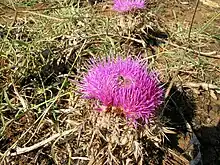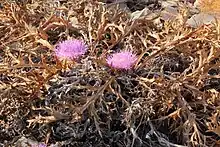Chamaeleon gummifer
Chamaeleon gummifer, also known as distaff thistle or stemless atractylis, is a thistle in the Chamaeleon genus. Formerly, it was placed in the Atractylis genus.[1] It is native to the Mediterranean basin, where it can be found in various habitats, including cultivated- or uncultivated fields and forests.[3][1] It is a perennial herb producing a stemless, pinkish flower. The plant has a history of use in folk medicine, but it is very toxic due to the presence of atractyloside and carboxyatractyloside.[4]
| Chamaeleon gummifer | |
|---|---|
 | |
| Flowering specimen of Chamaeleon gummifer | |
| Scientific classification | |
| Kingdom: | Plantae |
| Clade: | Tracheophytes |
| Clade: | Angiosperms |
| Clade: | Eudicots |
| Clade: | Asterids |
| Order: | Asterales |
| Family: | Asteraceae |
| Genus: | Chamaeleon |
| Species: | C. gummifer |
| Binomial name | |
| Chamaeleon gummifer (L.) Cass. | |
| Synonyms[2] | |
| |
Description

Chamaeleon gummifer is a perennial thistle with a long rhizome extending up to 40 cm and spiky leaves emanating from its center.[5][4] A pinkish inflorescence grows in the center, seen as a capitulum consisting of many small threadlike flowers.[4] The inflorescence is surrounded by spiny bracts.[5] Unusual compared to other thistles is the fact that the inflorescence of Chamaeleon gummifer does not grow on a stem. The ripe fruit of the plant may ooze a white or yellowish gummy latex produced by the rhizome.[4] Chamaeleon gummifer flowers in late summer or early autumn.[3]
Distribution
Chamaeleon gummifer can be found along the Mediterranean basin, including Northern Africa, the Iberian Peninsula, Italy, Greece and Malta.[1][3] It grows in various habitats and on various substrates, including in cultivated- or uncultivated fields, shrublands, forests and in rocklands.[1] It is rated as Least Concern on the IUCN Red List.[1]
Toxicity
The toxicity of Chamaeleon gummifer is thought to be caused by two related glycosides, atractyloside and carboxyatractyloside.[4] In Morocco, Chamaeleon gummifer is a common cause of plant poisoning, with children being especially vulnerable to severe effects.[6] Accidental ingestion of the plant can be due to confusion with the artichoke thistle, or due to use of its gummy discharge as a chewing gum.[6] Fatal cases of poisoning are not uncommon, even with treatment of symptoms.[6][7] At least 98 fatalities occurred due to Chamaeleon gummifer poisoning in Morocco between 1981 and 2004, most of whom were children under the age of 16.[8] Severe cases may be associated with liver and kidney failure.[9][7] There is currently no specific treatment to poisoning by Chamaeleon gummifer.[4]
References
- Rankou, Hassan; Taleb, Mohammed; Ouhammou, Ahmed; Martin, Gary (2014-01-27). "IUCN Red List of Threatened Species: Carlina gummifera". IUCN Red List of Threatened Species. Retrieved 2021-04-08.
- "Chamaeleon gummifer (L.) Cass". Plants of the World Online. Royal Botanic Gardens, Kew. Retrieved 2 May 2021.
- Paul Portelli (13 Oct 2016). "A thistle in the daisy family". Times of Malta. Retrieved 2021-04-07.
- Daniele, C.; Dahamna, S.; Firuzi, O.; et al. (2005-02-28). "Atractylis gummifera L. poisoning: an ethnopharmacological review". Journal of Ethnopharmacology. 97 (2): 175–181. doi:10.1016/j.jep.2004.11.025. ISSN 0378-8741. PMID 15707749. Retrieved 2021-04-07.
- Mifsud, Stephen (2002-08-23). "Atractylis gummifera (Stemless Atractylis) : MaltaWildPlants.com - the online Flora of the Maltese Islands" (Web Page). Retrieved 2021-04-09.
- Achour, S.; Rhalem, N.; Elfakir, S.; et al. (November 2013). "Prognostic factors of Atractylis gummifera L. poisoning, Morocco". Eastern Mediterranean Health Journal. 19 (11): 953–959. doi:10.26719/2013.19.11.953. ISSN 1020-3397. PMID 24673087.
- Hamouda, C.; Hédhili, A.; Ben Salah, N.; et al. (June 2004). "A review of acute poisoning from Atractylis gummifera L". Veterinary and Human Toxicology. 46 (3): 144–146. ISSN 0145-6296. PMID 15171492.
- Hami, H.; Soulaymani, A.; Skalli, S.; et al. (2011-02-01). "Intoxication par Atractylis gummifera L. Données du centre antipoison et de pharmacovigilance du Maroc". Bulletin de la Société de pathologie exotique. 104 (1): 53–57. doi:10.1007/s13149-010-0102-8. ISSN 1961-9049. PMID 21243460. Retrieved 2021-04-09.
- Georgiou, M.; D, Biol; Sianidou, L.; et al. (1988-01-01). "Hepatotoxicity due to atractylis gummifera-L". Journal of Toxicology: Clinical Toxicology. 26 (7): 487–493. doi:10.3109/15563658809038564. ISSN 0731-3810. PMID 3230599. Retrieved 2021-04-07.
